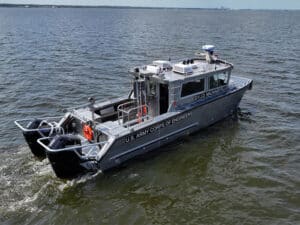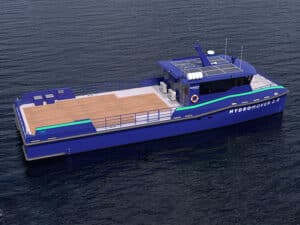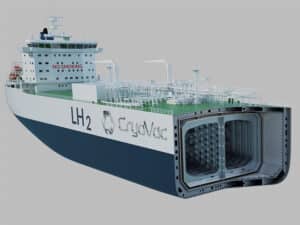
Cummins introduces world’s most powerful high speed diesel
Written by Cummins Inc. (NYSE: CMI) has introduced its new QSK95 engine with over 4,000-hp (2,983 kW) output, describing it as “the world’s most powerful high-speed diesel.”
Cummins Inc. (NYSE: CMI) has introduced its new QSK95 engine with over 4,000-hp (2,983 kW) output, describing it as “the world’s most powerful high-speed diesel.”
The 95-liter 16-cylinder QSK95 is the first engine to be introduced in a new high-horsepower diesel and gas series from Cummins. The new product line will extend up to the 120-liter 20-cylinder QSK120, capable of over 5,000-hp (3728 kW) output.
Cummins says the engine is designed with exceptional strength and high power density.

The 16-cylinder QSK95 exceeds the power output of other large 1,800-rpm high-speed engines with 20-cylinders. Compared with much larger medium-speed engines operating below 1,200 rpm, the QSK95 offers a more compact and cost-effective solution to achieve the same power output.
The QSK95 is said to be ideally suited for high-hour, high-load applications in many types of marine vessels and that operators can expect higher levels of equipment uptime and a longer life-to-overhaul with the QSK95.
The QSK95 is ready to meet the most stringent emissions standards, including EPA Tier 4 Final, taking effect in 2015, using proven Selective Catalytic Reduction (SCR) aftertreatment designed by Cummins to replace the exhaust muffler.
“Our new QSK95 represents a landmark in the evolution of the large high-speed diesel engine, designed with the power and durability to surpass all other high-speed engines while also challenging much larger and higher capital cost medium-speed engines,” said Mark Levett, Cummins Vice-President and General Manager – High-Horsepower Business.
“The QSK95 moves Cummins into a significantly higher power class, and we know that many of our customers have been eagerly anticipating us making that move. During the development of the QSK95, we engaged with hundreds of potential users to ensure that we fully reflected their operational and installation needs.
“That’s why we purpose-designed the QSK95 to set standards of uptime availability and in-service reliability higher than those of any other engine – because our customers see that as a top priority for their business success.
“We are excited to introduce the QSK95, as this is just the start of a new high-horsepower platform for both diesel and gas, covering 12, 16 and 20 cylinders. The gas engines will not be just a derivative of the diesel engines, but uniquely designed for gas. We will release more details about our gas product line during 2013,” added Levett.
The QSK95 is pre-engineered to add four cylinders and will achieve over 5,000-hp (3728 kW) with the QSK120 engine, moving the boundaries of high-speed diesel performance even further ahead. The QSK120 will utilize the same architecture and systems as the QSK95, providing the advantage of platform commonality.
Cummins has committed major resources to the new QSK95 and the high-horsepower platform, with 150 engineers working on the project and over $100 million invested to establish a new production line and world-class test facilities at the Seymour Engine Plant.
QSK95 Analysis-Led Design
The QSK95 has been developed using state-of-the art analytical tools, including highly advanced combustion modeling.
Jim Trueblood, Vice-President – Cummins High-Horsepower Engineering, explains:
“Using powerful analysis programs, we evaluated thousands of possible combustion designs until we arrived at the optimum formula for fuel efficiency, performance, emissions control and power cylinder durability before cutting any metal for the QSK95.
“The QSK95 is designed with immense strength at the heart of the engine, enabling the power cylinder to achieve higher levels of peak cylinder pressure. This gives a higher threshold in-cylinder to focus on emissions reduction and improve fuel efficiency.
“A key achievement of our combustion analysis-led work is that the QSK95 makes no performance compromise to meet very low emissions standards – an advantage that few, if any, other large high-speed or medium-speed engines will be able to claim for Tier 4.”
Using Proven Performance Systems
While the QSK95 is an all-new platform, the engine has been able to take advantage of proven performance systems from within Cummins high-horsepower technology portfolio.
A quad-turbocharger system brings highly reliable air-handling direct from the QSK60 engine to the QSK95. The four compact turbochargers provide outstanding step-load acceptance and transient response with the simplicity of single-stage operation.
The Modular Common-Rail System (MCRS) is upgraded to a next-generation design with up to 2,200-bar high-pressure fuel injection. MCRS achieves high fuel efficiency, reduces noise, offers smooth idle stability and eliminates visible smoke across the operating range.
Cummins new NanoNetTM fuel filtration gives superior fuel cleanliness and enhances the durability of the MCRS system – an important advantage for engines required to operate anywhere in the world with varying fuel quality.
Deep Structural Strength
A new ductile iron block and an extended block skirt ensure the highest possible structural strength for the QSK95, improving its capability for multiple overhauls. An internal stiffening bedplate minimizes vibration.
A single-piece forged-steel piston provides exceptional durability and reuse capability at rebuild. All three piston rings use premium materials, with the top ring Plasma Vapor Deposition (PVD)-coated. The hardened power cylinder features midstop cylinder liners and dual piston cooling nozzles, contributing to reduced piston ring temperatures and increased wear resistance.
The stronger engine design of the QSK95 means more reliability in-service and less to rebuild at engine overhaul, considerably reducing total life cycle costs. The QSK95 will provide an exceptionally long life-to-overhaul, capable of achieving 1.7 million gallons and above of fuel consumed before overhaul, with the significant advantage of no mid-life intervention required.
Meeting Ultra-Low Emissions Standards
The SCR after-treatment system is purpose-designed for the QSK95 to provide a highly flexible, installation package for Tier 4 Final and similar ultra-low emissions standards. Design space remains available within the aftertreatment system configuration for additional Particulate Matter (PM) reduction technology if required for specific applications.
Depending on the duty-cycle, the Cummins SCR system is capable of achieving fuel savings of 5 percent to 10 percent, together with a significant reduction in carbon dioxide (CO2) emissions. The SCR fuel savings are incremental to those already realized by the high-pressure fuel system, reducing the cost of operation by more than the cost of Diesel Exhaust Fluid (DEF) required for the SCR system.
By using Cummins SCR after-treatment solution, the QSK95 avoids the need for an Exhaust Gas Recirculation (EGR) system on the engine to reduce NOx. This EGR-free approach avoids the inherent complexity of applying it to high-output engines and means that no compromise is made to serviceability. A further advantage is that no additional heat rejection is generated by the engine, avoiding both an installation cost and space impact.
Increased Uptime And Serviceability
The QSK95 is designed with more inherent reliability to ensure the highest possible uptime availability. The engine is configured to provide faster and easier servicing procedures, with simple access to all cooling, oil and fuel system maintenance points on the engine. Service intervals are a minimum 500 hours, with the option of much-extended oil change intervals available using the ELIMINATOR oil purification system, mounted on the engine.
The goal of a leak-free engine is achieved by premium “press-in-place” seals on all critical joints, such as flywheel housing, gear housing and oil pan-to-cylinder block. A special perimeter seal to the cylinder head guarantees that airborne debris cannot penetrate this important sealing interface.
Four standardized Cummins Electronic Control Modules (ECMs) provide a high level of processing power and memory to monitor, control and protect the engine systems. One ECM monitors each engine quadrant, with all four ECMs grouped together for easy access at the front of the engine in a protected cover. An easy interface provides access for full diagnostics.
November 2, 2011





Leave a Reply
You must be logged in to post a comment.